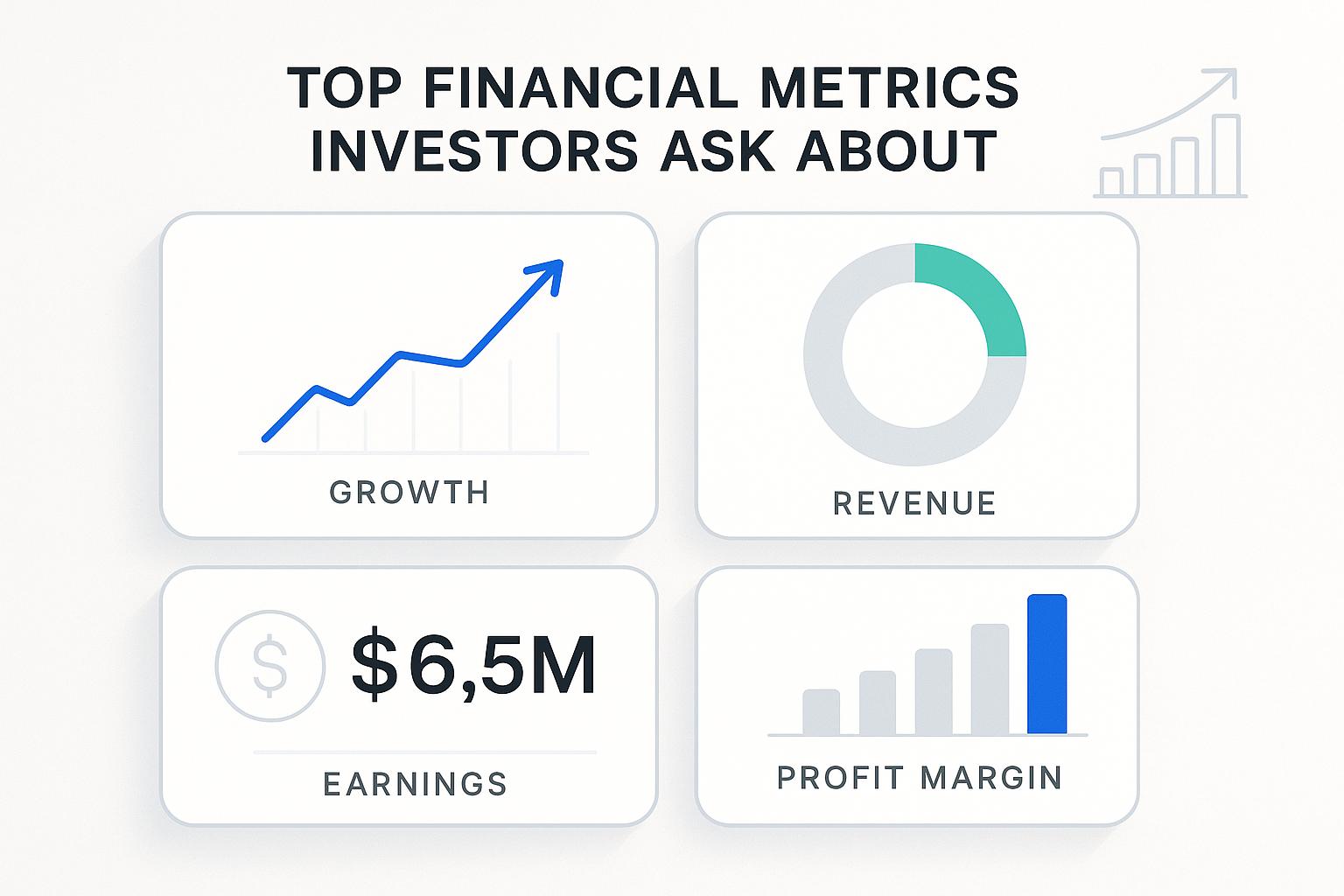Cohort analysis is a powerful way to understand user behavior by grouping customers based on shared characteristics like signup date, plan type, or actions taken. This helps SaaS companies improve retention, track customer lifetime value (LTV), and reduce churn. In 2025, AI-powered tools make this process faster and more precise, offering predictive insights and automated reporting.
Here are the top 10 cohort analysis tools for SaaS businesses in 2025:
- Amplitude: Advanced behavioral analytics with customizable cohorts and AI-driven insights. Free plan available; paid plans start at $995/month.
- Mixpanel: Focuses on user behavior with retention tracking and funnel analysis. Free plan supports up to 1,000 users; paid plans start at $25/month.
- Heap: Automatic event tracking and retroactive cohort creation. Free plan available; paid plans start at $300/month.
- Julius AI: AI-powered analysis with natural language queries and predictive insights. Starts at $99/month.
- Houseware: Works directly with data warehouses for real-time cohort insights. Custom pricing based on usage.
- ChartMogul: Subscription analytics with MRR, ARR, and churn tracking. Free for <$10K MRR; paid plans start at $99/month.
- PostHog: Open-source analytics for product teams with self-hosted and cloud options. Free for self-hosted; cloud plans start at $100/month.
- Google Analytics 4 (GA4): Free tool for web and app cohort analysis; enterprise version starts at $1,042/month.
- OpenEpi: Free tool for health-focused cohort analysis, ideal for epidemiology studies.
- Lucid Financials: Combines financial management with cohort analysis. Starts at $150/month per service area.
Quick Comparison:
| Tool | Key Features | Pricing | Best For |
|---|---|---|---|
| Amplitude | Behavioral analytics, predictive AI | Free/$995+/month | Product teams, large SaaS businesses |
| Mixpanel | Funnels, retention tracking | Free/$25+/month | Growth teams, startups |
| Heap | Automatic data capture | Free/$300+/month | Teams with limited engineering support |
| Julius AI | AI-driven insights, no-code | $99+/month | Startups, non-technical teams |
| Houseware | Data warehouse-native analytics | Custom pricing | Data-heavy SaaS companies |
| ChartMogul | Subscription metrics | Free/$99+/month | Finance teams, subscription SaaS |
| PostHog | Open-source, self-hosted option | Free/$100+/month | Developers, technical teams |
| Google Analytics 4 | Free web/app tracking | Free/$1,042+/month | Businesses of all sizes |
| OpenEpi | Health-focused analytics | Free | Epidemiology research |
| Lucid Financials | Financial + cohort analysis | $150+/month | Startups needing financial insights |
Each tool caters to specific needs, from startups to large enterprises. Choose based on your team's size, budget, and technical expertise.
What is Cohort Analysis? | SaaS Metrics School | SaaS Tips and Tricks | Cohort Analysis Templates
1. Amplitude
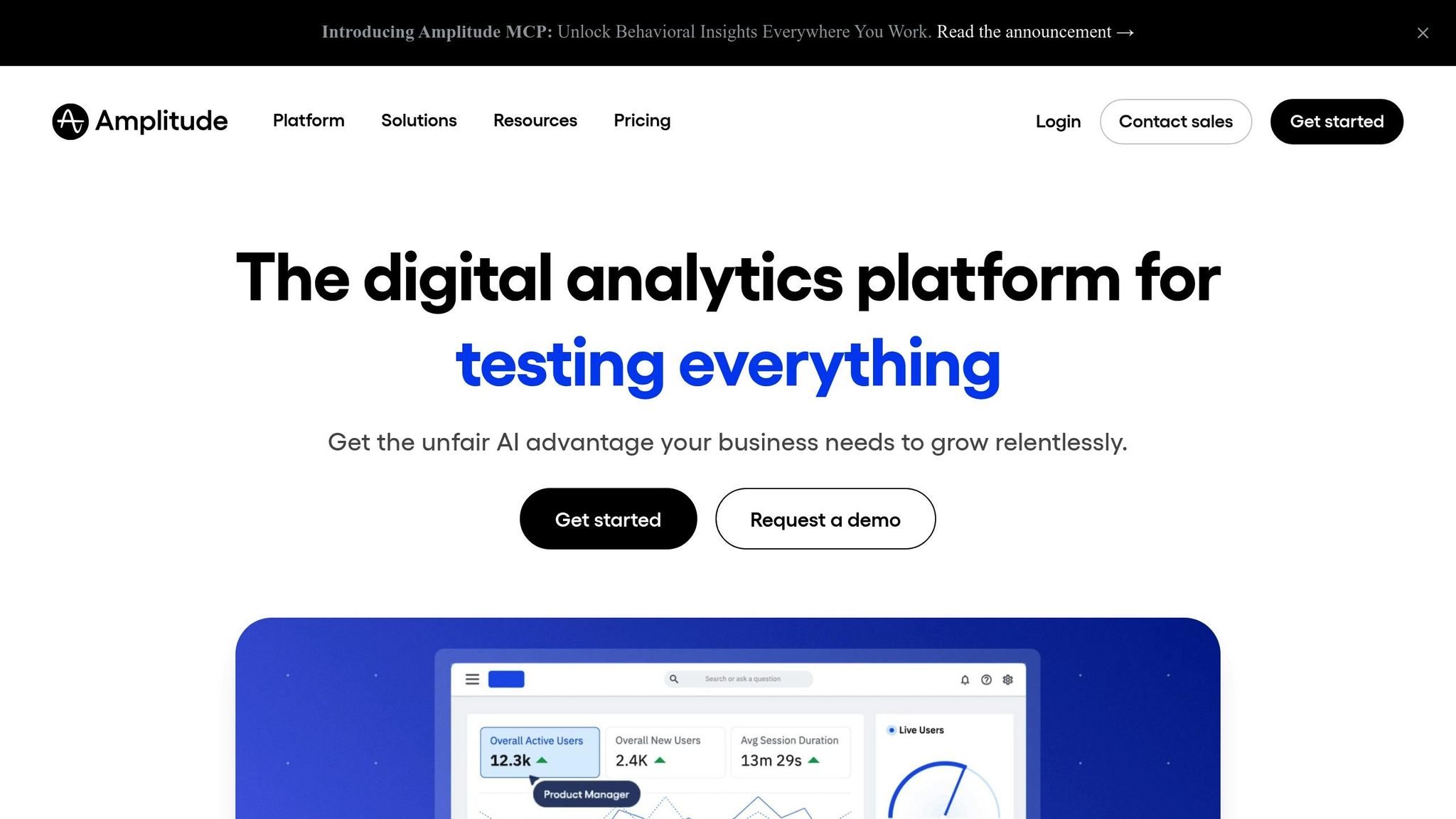
Amplitude is a behavioral analytics platform trusted by more than 45,000 digital products worldwide. It transforms user data into actionable insights, helping businesses make smarter product decisions and improve retention.
Cohort Analysis Capabilities
Amplitude's cohort analysis is highly customizable, allowing you to create user groups based on virtually any behavior or property. Whether it's signup dates, feature usage, engagement levels, or conversion actions, you can link specific user behaviors to long-term retention and revenue growth.
One standout feature is its ability to connect onboarding actions to lifetime value. This helps businesses monitor how acquisition channels perform over time and identify early signs of churn before they become significant issues. Companies using Amplitude have reported up to 30% gains in user retention after leveraging cohort-driven product changes.
Its user-friendly dashboards make it easy to track trends and share insights across teams, ensuring everyone stays aligned on data-driven decisions. Plus, Amplitude integrates seamlessly with other tools to create a smooth data workflow.
Integration with SaaS Tools
Amplitude connects effortlessly with popular tools like Segment, Snowflake, HubSpot, Salesforce, and Slack. These integrations unify data from product, marketing, and sales teams, providing a full view of the customer journey - from the first interaction to renewal.
For added convenience, Amplitude offers pre-built templates for common analyses, such as retention, activation, and churn tracking. These templates allow businesses to get started quickly without having to build everything from scratch, speeding up the process of turning data into insights.
Pricing (USD/month)
Amplitude provides a free plan with core analytics and cohort features, ideal for early-stage startups exploring product-market fit. For scaling businesses, the Growth plan starts at around $995/month (as of late 2025), with custom pricing available for enterprise needs and larger data volumes.
Pricing depends on the number of monthly tracked users and the features you need, making it adaptable for businesses at different stages of growth.
Startup Scalability
Amplitude is designed to grow with your business, handling increasing data complexity as your startup scales. Whether you're refining your product for market fit or managing large-scale operations, the platform's flexible cohort definitions and robust analytics ensure your insights remain relevant.
Users consistently rate Amplitude between 4.5–4.7 out of 5 stars on major review platforms, highlighting its intuitive cohort builder and insightful dashboards. While mastering advanced features may take some time, the effort pays off as your analytics needs become more complex.
Startups often rely on Amplitude to refine onboarding processes, prioritize product roadmaps, and identify the features that drive lasting engagement. Its AI-powered insights uncover patterns that might be missed with manual analysis, helping businesses seize opportunities and address challenges effectively.
2. Mixpanel
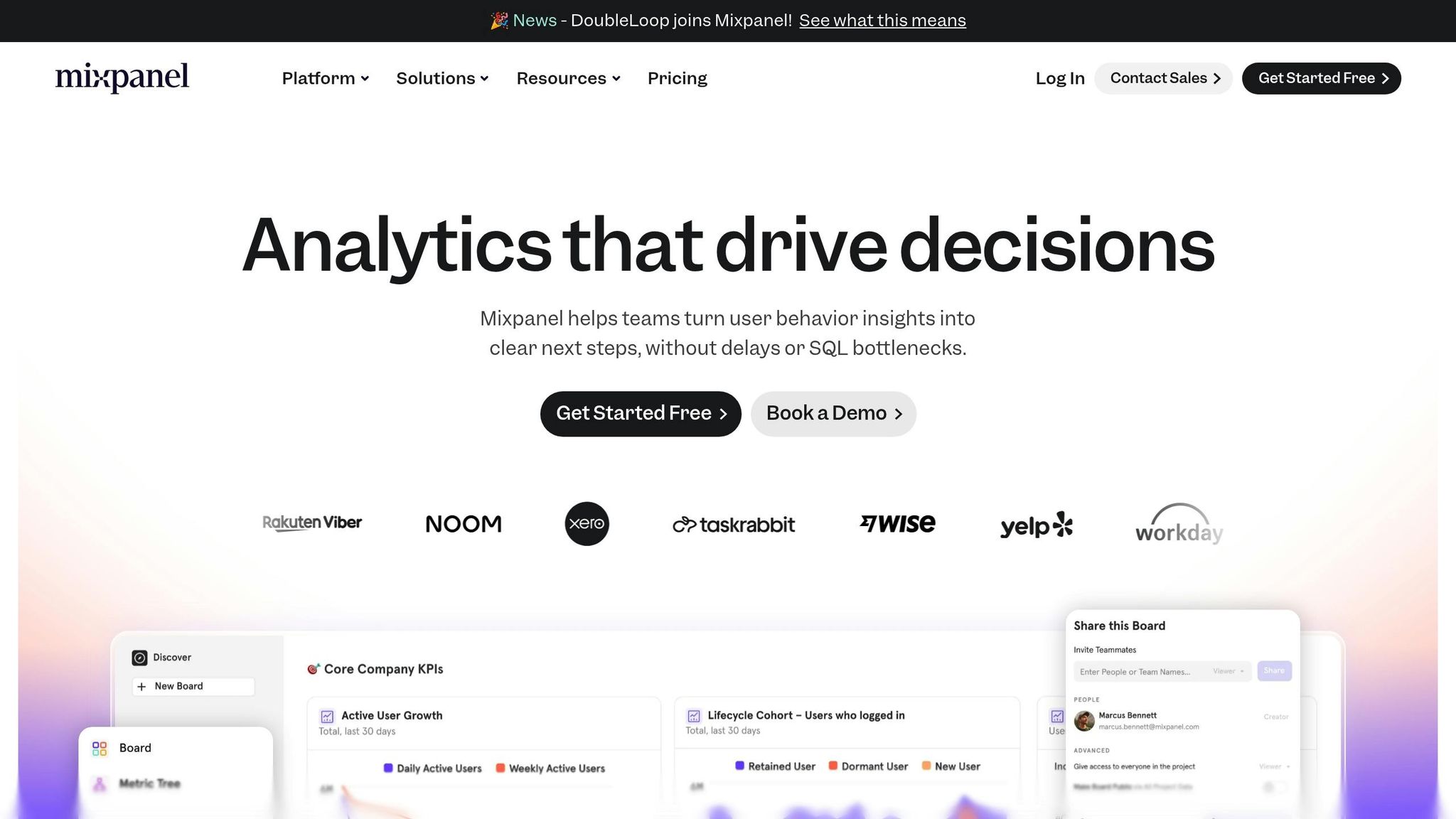
Mixpanel is a product analytics platform designed to help businesses understand user behavior. With an impressive 4.7 out of 5 star rating from users, it has become one of the top three tools for cohort analysis in 2025. Known for its fast self-serve funnels and event-based tracking, Mixpanel is a go-to choice for many SaaS teams. Like Amplitude, it incorporates AI to enhance predictive analytics.
Cohort Analysis Capabilities
Mixpanel's behavioral cohort analysis allows SaaS teams to segment users based on actions, engagement patterns, and lifecycle stages[5, 11]. It also provides retention cohort charts that align with financial metrics like lifetime value and revenue.
What sets Mixpanel apart is its advanced behavioral segmentation and flexible reporting. Teams can build custom user segments using various behaviors and properties, then monitor these groups with detailed funnel visualizations and interactive dashboards[5, 11]. These tools make it easy to identify drop-off points and conversion trends[5, 11].
In 2025, Mixpanel introduced AI-powered insights for cohort analysis. This feature automatically flags retention risks and offers predictive analytics to forecast user behavior trends. Additionally, teams can export reports and tables for further analysis using other tools.
Integration with SaaS Tools
Mixpanel shines when it comes to integrations, offering native connections with over 100 apps and a robust API for custom setups[4, 11]. It integrates seamlessly with platforms like Salesforce, HubSpot, and Segment, as well as cloud data warehouses, enabling unified analytics across tools. These integrations are especially useful for product-led growth strategies, helping teams identify which features drive revenue and flagging potential churn risks early on.
Pricing (USD/month)
Mixpanel provides a free plan that supports up to 1,000 monthly tracked users (MTUs). Paid plans start at $25/month, scaling up to $150/month as user volume and feature requirements grow[4, 11]. For larger organizations with more complex needs, custom enterprise pricing is available. This flexible pricing structure allows startups to start small with the free plan and increase their investment as their user base expands.
Startup Scalability
Mixpanel is built to grow alongside startups, handling everything from hundreds to millions of users without losing performance quality. Its infrastructure is optimized for managing large datasets and running complex queries efficiently[8, 11].
The platform is particularly suited for product-focused SaaS teams looking for deep behavioral analytics that can drive growth and boost revenue[5, 7, 11]. Its user-friendly interface and robust reporting tools make it a favorite for teams aiming to improve retention and map out user journeys - all without needing advanced technical skills.
3. Heap
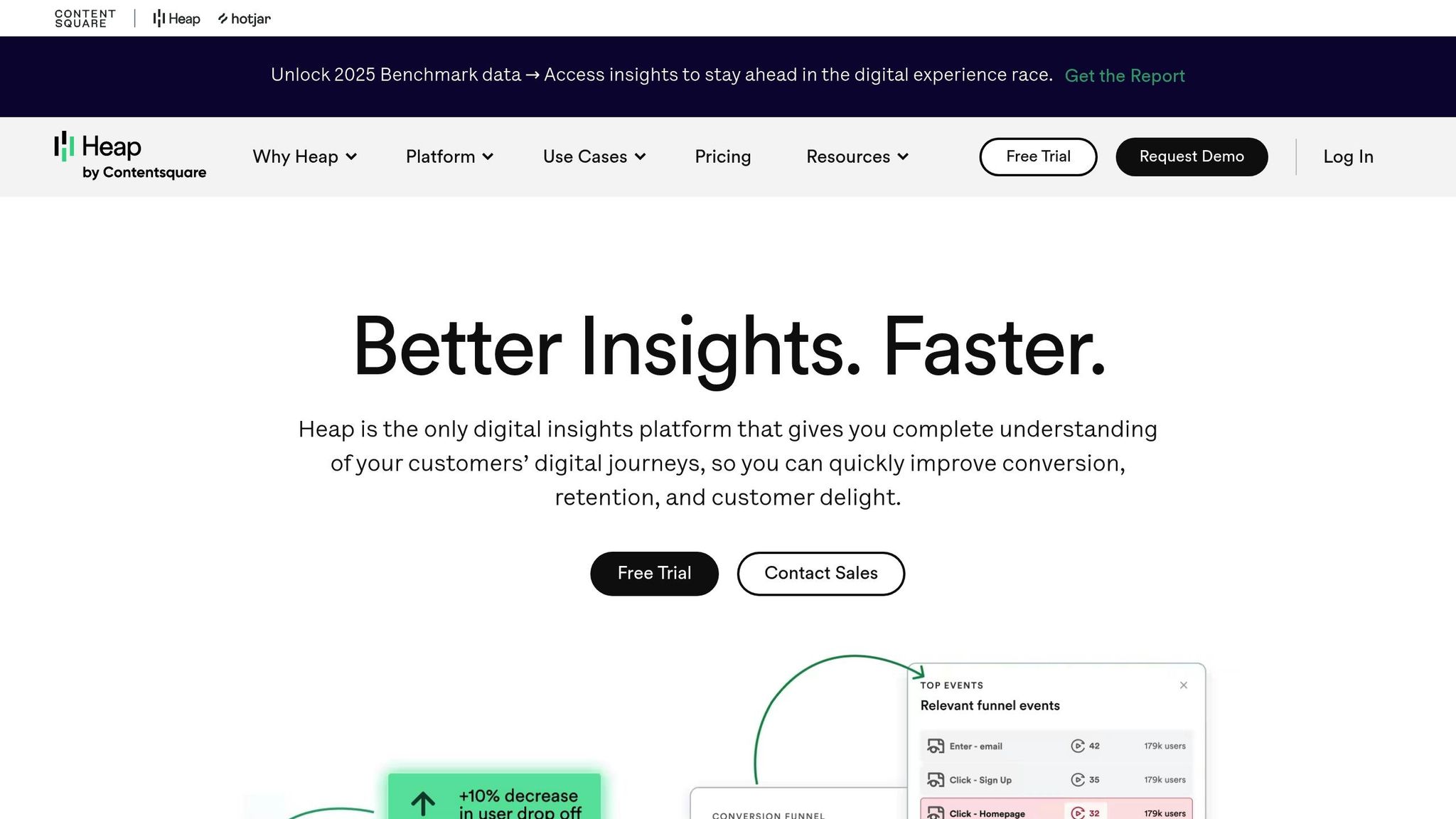
Heap brings a fresh approach to cohort analysis with its automatic data capture system, eliminating the need for manual event tracking. This platform automatically logs every interaction users have with your product, giving you the ability to create detailed cohorts retroactively - no pre-planned tagging required. As of 2025, Heap remains a top choice among SaaS companies, especially for teams looking to cut down on engineering workload.
Cohort Analysis Capabilities
Heap’s automatic data capture takes cohort analysis to the next level with its granular segmentation capabilities. Its standout feature is the ability to segment users based on any combination of actions, properties, or timeframes, all retroactively. This means you can define precise cohorts without needing to set up tags in advance.
Beyond standard retention metrics, Heap allows for custom cohort segmentation. Teams can map out complex user journeys, pinpoint drop-off points in multi-step processes, and analyze behaviors using Heap’s comprehensive data collection. These custom segments can be saved, compared, and tracked over time, enabling more targeted insights into retention, engagement, and conversions.
For instance, one team discovered that users who completed onboarding within the first 24 hours had a 40% higher retention rate at 90 days. By creating a cohort of these users and analyzing their behavior, they optimized the onboarding process, leading to a 15% boost in overall user retention.
Integration with SaaS Tools
Heap integrates seamlessly with a range of popular SaaS tools, including CRMs, marketing automation platforms, and data warehouses. This integration allows teams to combine product analytics with customer, marketing, and financial data, offering a complete view of user behavior throughout the customer lifecycle.
For example, integrating Heap with a CRM can reveal how sales-qualified leads behave after signing up, while connections to data warehouses enable advanced reporting and business intelligence workflows. Its broad integration ecosystem makes Heap a versatile choice for both startups and large enterprises.
Pricing (USD/month)
Heap’s features are offered through a tiered pricing model based on usage and functionality. A free plan with basic features is available, while paid plans start at around $300 per month (approximately $3,600 annually) for startups. Higher-tier plans include advanced features like retroactive analysis, deeper integrations, and dedicated support, with custom pricing options for larger enterprises.
This flexible pricing model allows startups to start small with basic analytics and scale up to more sophisticated cohort analysis as their data needs grow.
Startup Scalability
Heap is designed to grow alongside startups, handling increasing data volumes and user counts effortlessly. Its automatic event tracking lets teams iterate quickly without needing to reconfigure analytics setups.
The platform’s infrastructure supports millions of users while maintaining performance, and its adaptable cohorting tools evolve with changing business needs. This makes Heap an ideal fit for both early-stage startups and rapidly scaling SaaS companies that need fast, reliable, and in-depth analytics without adding extra engineering overhead.
4. Julius AI
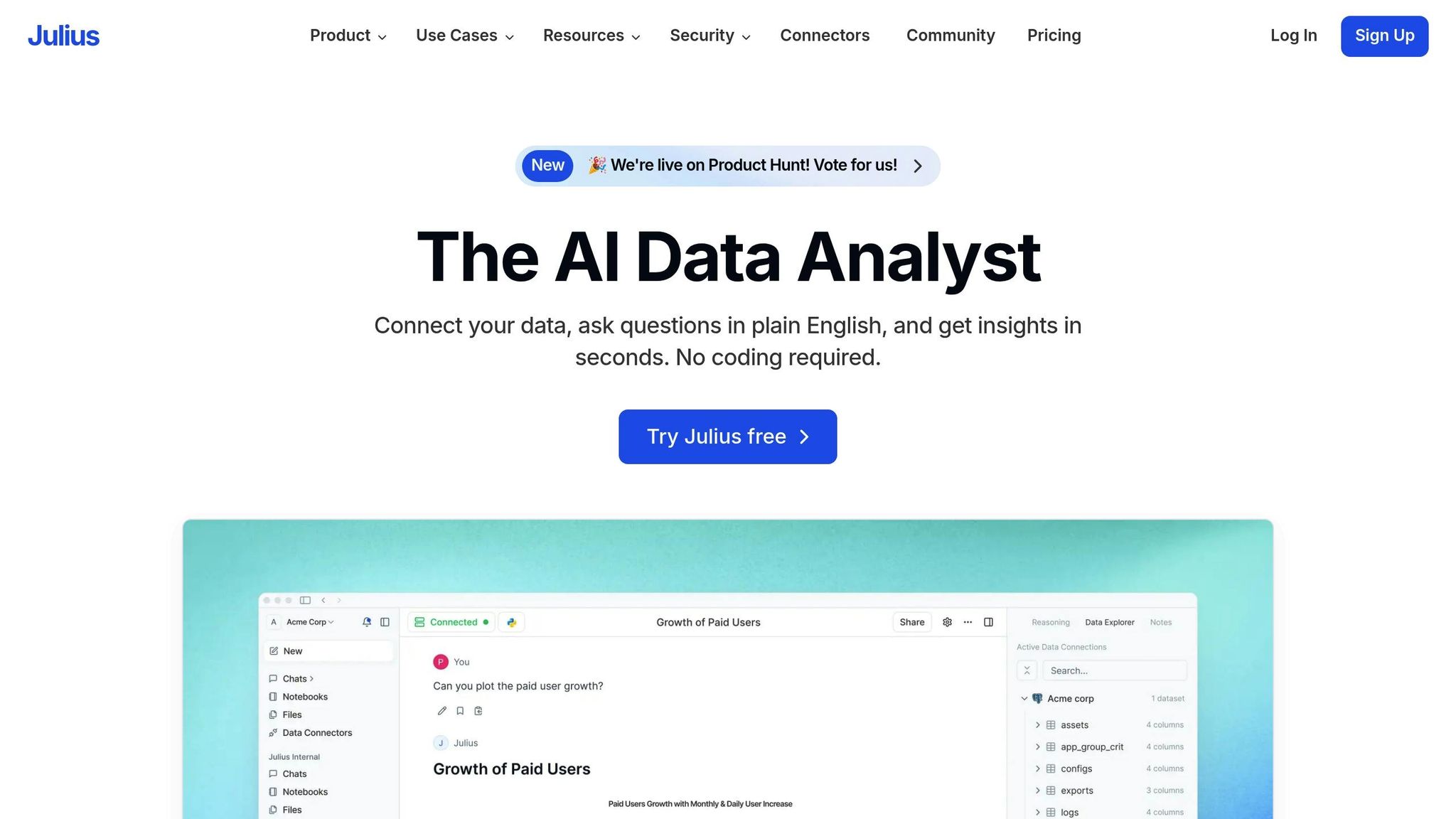
Julius AI brings artificial intelligence into your analytics workflow, automatically identifying patterns and anomalies to highlight early churn risks and link feature engagement to lifetime value. With its natural language processing, you can ask questions in plain English and get instant cohort analysis results - all through a no-code interface. According to user feedback, the platform has cut cohort analysis time by 80%, allowing startup teams to shift their focus from data preparation to growth strategies. Let’s dive into how Julius AI transforms cohort analysis.
Cohort Analysis Capabilities
Julius AI makes grouping users easy, whether by acquisition channel, feature usage, subscription tier, or custom events - all without any manual setup. You can even combine filters to create highly targeted cohorts. For example, you might analyze users acquired through Google Ads who didn’t engage with a core feature during their first month.
The platform’s interactive dashboards and real-time updates provide visualizations like heatmaps, line charts, and retention curves, making it simple to track trends at a glance. Reports can be tailored and exported in formats ideal for investor pitches or internal planning sessions.
With its machine learning algorithms, Julius AI doesn’t just present data - it also identifies actionable insights. It flags user behaviors linked to higher lifetime value and predicts which groups are likely to churn. This proactive approach gives SaaS companies the chance to address potential issues before they escalate, offering a more effective solution than traditional manual analysis.
Integration with SaaS Tools
Julius AI connects seamlessly with your existing tech stack, integrating with popular SaaS tools like CRMs, product analytics platforms, payment processors, and marketing automation systems. This integration ensures your cohort analysis captures the full customer journey, from acquisition to retention, without data silos.
The platform also supports real-time communication channel integration, so teams can receive updates and alerts instantly. This feature fosters immediate collaboration and faster decision-making. By combining product usage data, customer insights, and financial metrics, Julius AI provides a comprehensive view of your cohorts.
Pricing (USD/month)
Julius AI uses a tiered pricing structure based on the number of monthly active users and the integrations you need. Plans start at $99 per month, making it an affordable choice for startups. For larger organizations handling bigger data volumes or requiring advanced features, higher-tier plans are available.
For businesses with unique needs or substantial data requirements, custom enterprise pricing is also an option. All prices are in U.S. dollars and may include local taxes for U.S.-based customers.
Startup Scalability
Julius AI is designed to grow with your business, handling user bases from hundreds to millions without sacrificing performance. Its no-code interface is especially useful for startups with limited resources, enabling non-technical teams to perform advanced cohort analyses on their own.
As your company scales, Julius AI’s automation features reduce the need for manual work, freeing up your team to focus on strategic priorities instead of getting bogged down in data processing. This efficiency can be a game-changer for fast-growing businesses.
5. Houseware
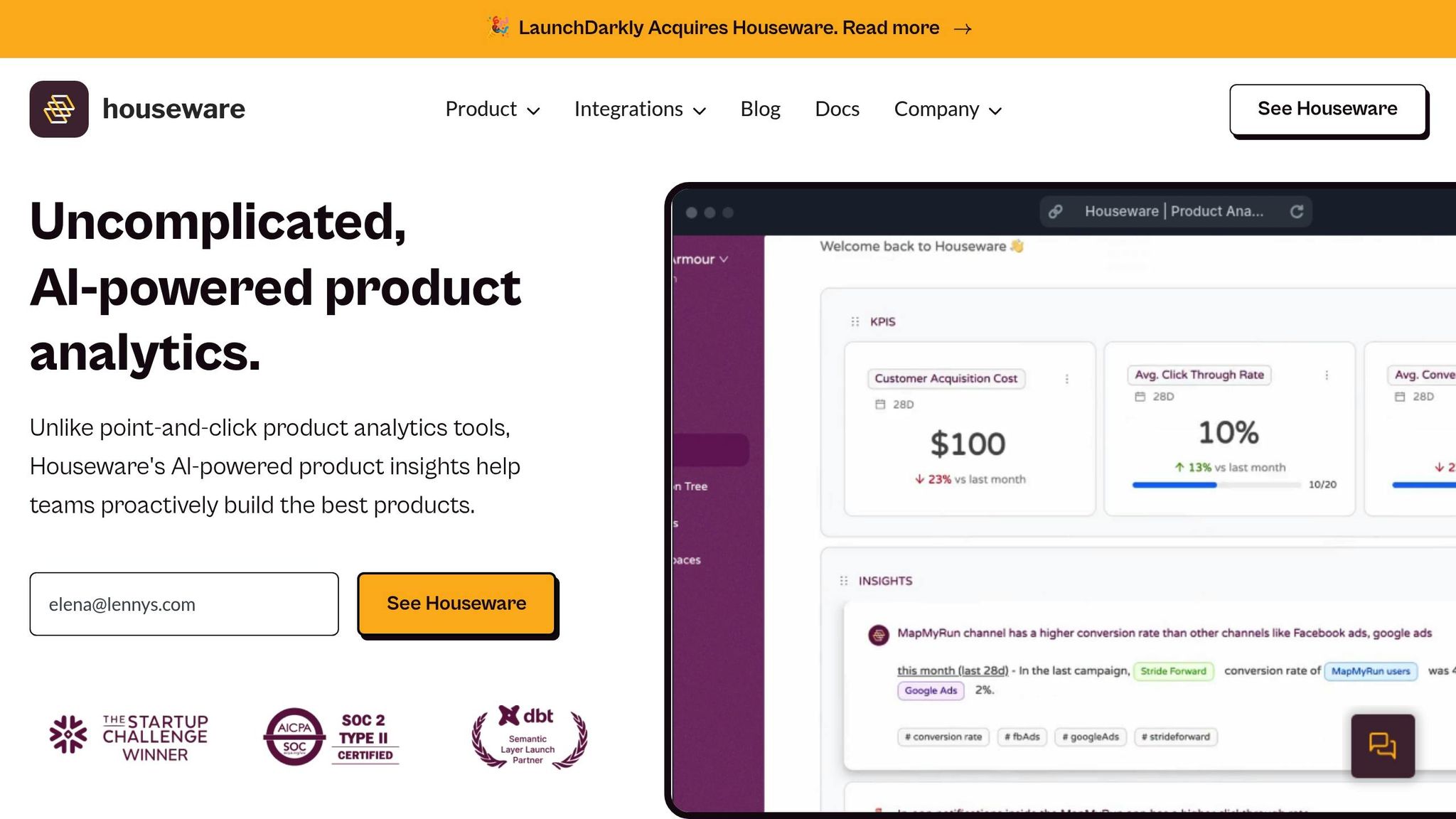
Houseware provides warehouse-native cohort analysis by directly connecting to platforms like Databricks, Snowflake, Redshift, or BigQuery - completely bypassing the need for data duplication. This approach allows SaaS teams to extract meaningful insights while ensuring their data remains secure. Unlike traditional analytics tools that rely on duplicating data, Houseware operates directly within your existing data warehouse environment, making it both efficient and secure.
What makes Houseware stand out is its no-code analytics. Marketing, product, and executive teams can perform advanced cohort analyses without needing SQL expertise. This self-serve model speeds up decision-making by eliminating the reliance on engineering teams. With a direct connection to your data, the platform offers real-time cohort insights that are both powerful and easy to access.
Cohort Analysis Capabilities
Houseware's segmentation tools let you group users based on factors like sign-up dates, product usage, and engagement behaviors - all directly from your data warehouse. It tracks essential SaaS metrics such as Monthly Recurring Revenue (MRR), Annual Recurring Revenue (ARR), Lifetime Value (LTV), and churn rates in real time. You can also create custom cohorts, for example, identifying users acquired through specific channels who didn’t engage with core features within their first month.
The platform’s AI-driven analytics go a step further, identifying behavioral patterns, predicting churn risks, and highlighting correlations between feature usage and customer lifetime value. For instance, a mid-sized SaaS company used Houseware to segment users by onboarding date and feature adoption. By targeting cohorts with high drop-off rates after the first week, they launched tailored onboarding campaigns, boosting week-two retention by 15% and reducing churn. Interactive dashboards, including heatmaps, line charts, and retention curves, make it easy to interpret complex data, spot trends, and share actionable insights across teams.
Integration with SaaS Tools
Houseware also integrates smoothly with popular SaaS platforms like CRMs, email marketing tools, product analytics systems, and payment processors. This integration eliminates conflicting metrics and provides a unified view of the customer journey, from acquisition to retention. Its warehouse-native design ensures data security and compliance with standards like SOC 2 and HIPAA. Additionally, real-time data exploration and embeddable dashboards make collaboration across teams more seamless.
Pricing (USD/month)
Houseware uses a flexible pricing model tailored to a company’s size and data needs, rather than fixed monthly tiers. To get a personalized quote, you’ll need to reach out to their sales team. This approach makes it particularly appealing for mid-to-large SaaS companies that have invested in modern data infrastructures. While specific pricing details aren’t publicly available, the platform is designed to deliver long-term value for organizations managing significant data volumes.
Startup Scalability
Houseware is built to scale alongside SaaS companies, whether they have thousands or millions of users. Its architecture is optimized to handle large data volumes without performance issues. Fast-growing startups can leverage its no-code analytics to conduct advanced cohort analyses without needing engineering support. As businesses grow, Houseware maintains a strong focus on data privacy and governance, ensuring compliance and security. Its custom cohort creation tools and AI-driven insights empower teams to make data-backed decisions at every stage of growth.
6. ChartMogul
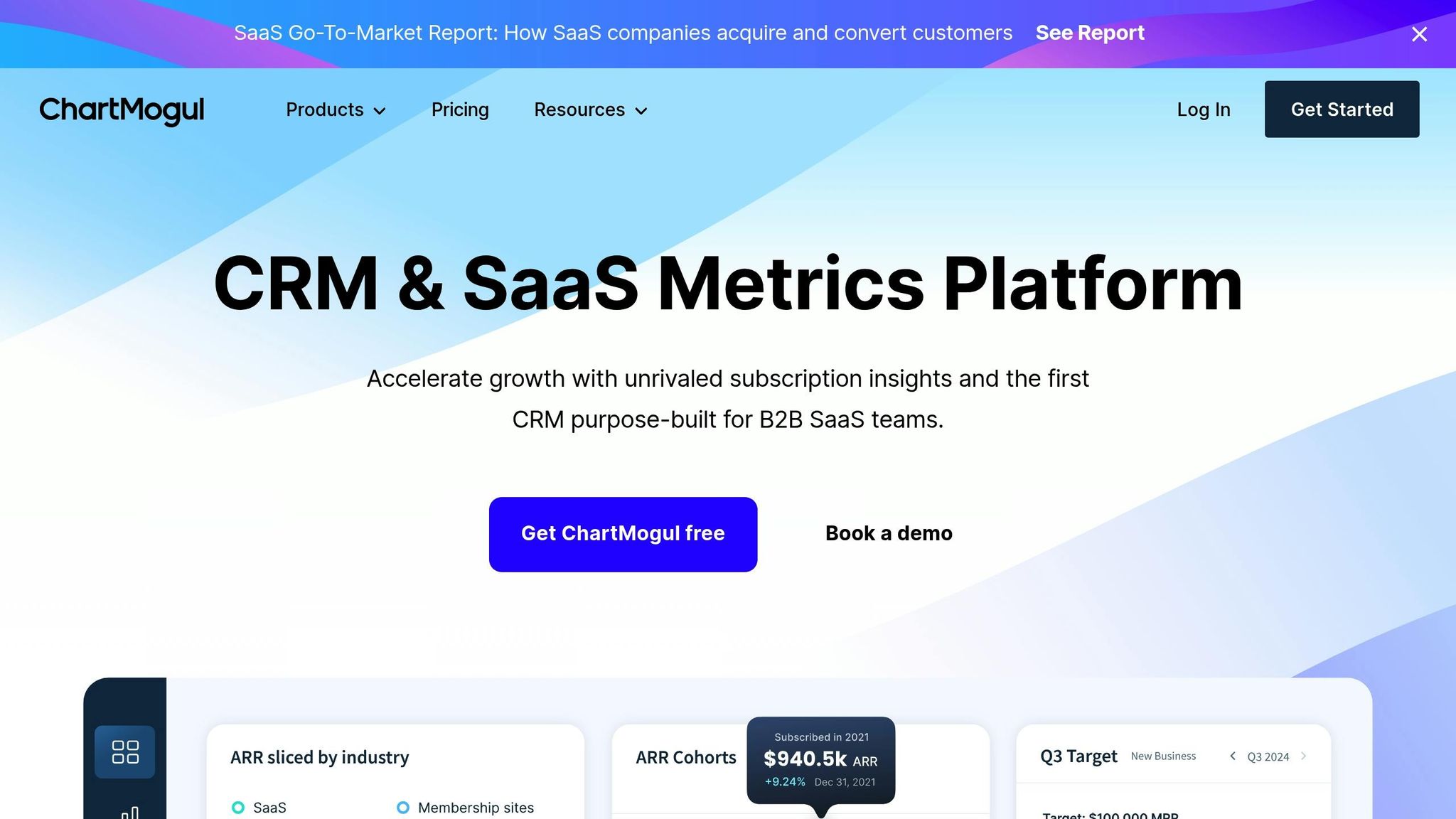
ChartMogul is a subscription analytics platform that turns billing data into detailed insights, focusing on key subscription and revenue metrics. It automatically calculates crucial SaaS performance indicators like Monthly Recurring Revenue (MRR), Annual Recurring Revenue (ARR), and churn rates directly from your billing information.
Cohort Analysis Capabilities
ChartMogul's cohort analysis tools allow you to group and analyze customers based on factors like signup date, subscription plan, location, acquisition channel, or even custom attributes. For instance, you can compare how retention differs between annual and monthly subscribers. The platform’s interactive dashboards, featuring retention curves, churn heatmaps, and cohort comparison charts, simplify complex data, making it easier to make decisions backed by analytics.
On top of that, its integrations ensure a smooth flow of data from your billing systems.
Integration with SaaS Tools
ChartMogul connects seamlessly with popular billing platforms like Stripe, PayPal, Braintree, Recurly, and Chargebee. It also supports custom data sources through its API, syncing billing data automatically for precise cohort analysis. This unified approach reduces the need for manual data entry, streamlines reporting, and allows you to export enriched data to data warehouses or link it with external analytics tools for deeper insights.
Pricing (USD/month)
ChartMogul offers pricing that grows with your business. Startups earning less than $10,000 in MRR can use its free plan, while paid plans begin at $99/month and increase based on your needs. Higher-tier plans unlock advanced features like custom cohort segmentation and additional integrations. All U.S. customers are billed in USD, keeping pricing straightforward for SaaS startups as they scale.
Startup Scalability
Whether you're a small startup or a large enterprise, ChartMogul is built to grow with your team. Its cloud-based design can handle increasing data volumes and user demands, while features like flexible segmentation and customizable reports adapt to your company's evolving analytics needs. Automated data imports and granular cohort filters ensure that as your customer base grows, you’ll continue to have access to actionable insights. With a user satisfaction score of 4.5/5, ChartMogul has proven to be a reliable tool for tracking subscription metrics and empowering finance teams and executives to make strategic decisions.
sbb-itb-17e8ec9
7. PostHog
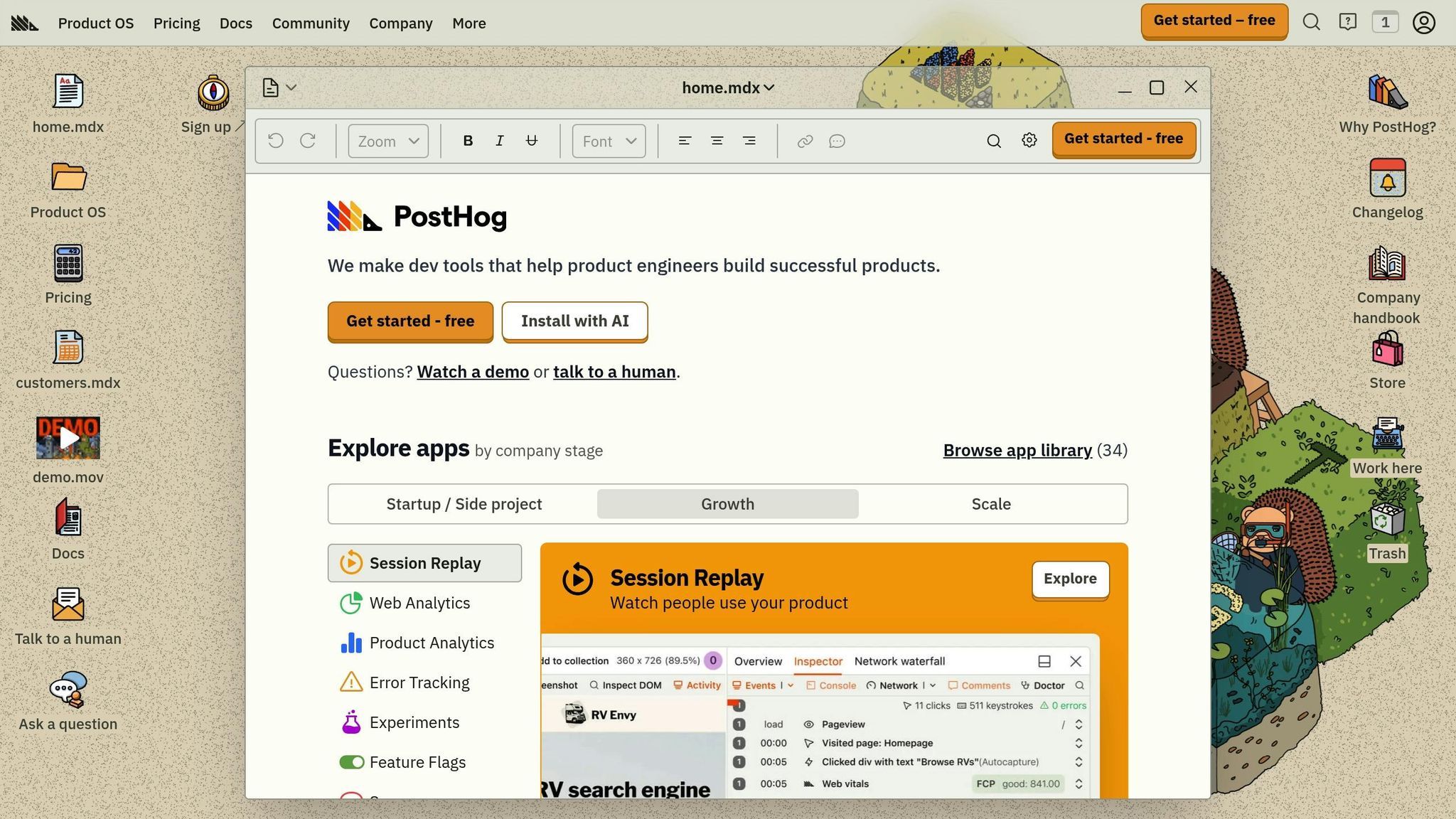
PostHog is an open-source analytics platform built with product teams in mind. It’s designed to give developers full control over their data while offering the flexibility to choose between free self-hosting or a managed cloud service for convenience.
Cohort Analysis Capabilities
PostHog’s cohort analysis tools let you group users based on shared traits like signup dates, feature usage, or custom properties. This makes it easier to compare retention trends and spot patterns in how users adopt features. For example, you can track users who joined during specific campaigns and analyze how long they stick around, helping you understand what drives engagement and reduces churn.
The platform also shines in behavioral segmentation. You can monitor users who complete particular actions within set timeframes. For instance, you might compare retention rates between users who finished onboarding in their first week and those who took longer, revealing potential friction points.
PostHog’s dashboards make it simple to present complex data with clear visuals, making it easier for non-technical team members to engage in data-driven discussions. These features, combined with its integration capabilities, make PostHog a strong choice for teams looking to dive deep into analytics.
Integration with SaaS Tools
PostHog integrates effortlessly with popular tools like Slack, Segment, and Zapier, enabling automated workflows, synchronized data, and action triggers based on cohort insights. Its developer-first API and SDKs allow for custom integrations, letting you embed analytics directly into your product. This level of customization ensures precise tracking and tailored cohort segmentation, making it a scalable option for startups with growing needs.
Pricing (USD/month)
PostHog offers two pricing models to fit different team requirements. The self-hosted option is free (you’ll only need to cover infrastructure costs), making it a great choice for teams with technical expertise or strict data privacy needs. For those who prefer a hands-off approach, the cloud-hosted option starts at $100 per month, which includes professional support and maintenance. U.S. customers are billed in USD, providing straightforward and predictable pricing as your business grows.
Startup Scalability
Whether you choose self-hosting or the cloud, PostHog is built to scale with your startup. Its flexible data storage can handle growing event volumes as your user base expands.
With a 4.3/5 user rating, PostHog has earned praise for its versatility, open-source foundation, and strong developer support. While its advanced features might require more technical setup - especially for self-hosted deployments - its ability to track virtually any user event or property makes it an excellent fit for SaaS products with unique user journeys.
8. Google Analytics 4
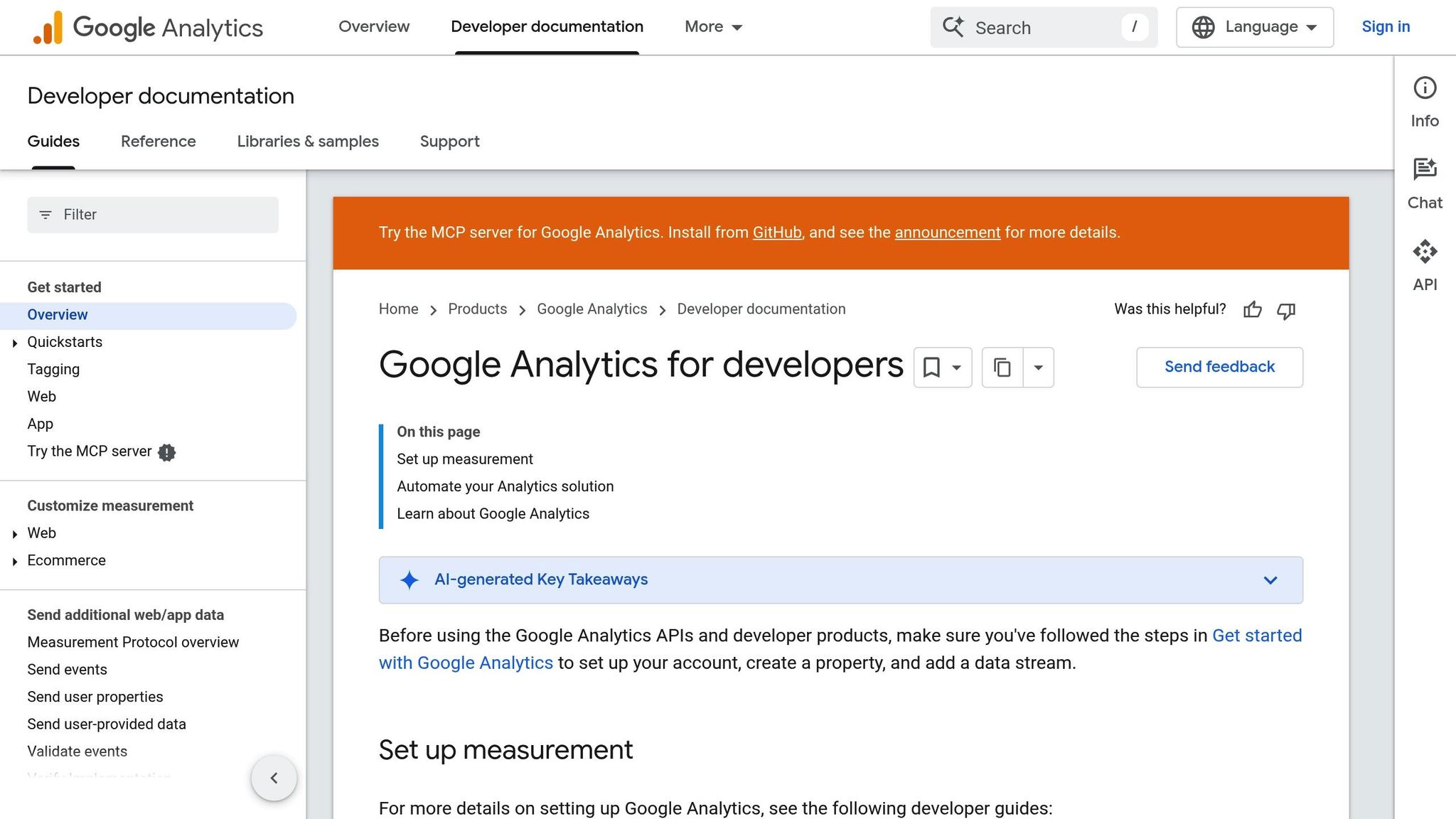
Google Analytics 4 (GA4) stands out as a free and powerful tool for cohort analysis, offering advanced user tracking without financial barriers. Its accessibility makes it a go-to solution for startups and established businesses alike, perfectly complementing other advanced tools in this space.
Cohort Analysis Capabilities
GA4 provides robust cohort analysis features that let you group users based on factors like acquisition date, behavior, or custom events. With these tools, you can monitor retention, engagement, and conversion rates using flexible cohort definitions - whether by signup date, first purchase, or key milestones. These insights help uncover patterns in how users interact with your product.
The platform's visualization tools, such as retention and churn charts, make it easy to identify trends in user behavior. For instance, you could create cohorts based on the month users started a free trial and track how their retention and conversion to paid plans change over time. Additionally, GA4's advanced funnel analysis offers a detailed view of user journeys, helping you identify where users drop off and what drives successful conversions.
Integration with SaaS Tools
GA4 integrates smoothly with a variety of SaaS tools, including CRM systems, marketing automation platforms, and product analytics solutions. It works seamlessly within Google's ecosystem and also connects with external APIs. Custom APIs allow you to combine data from multiple sources, providing a comprehensive view of the customer journey. This enriched data can significantly improve your cohort analysis, helping guide both product development and business strategies.
Pricing (USD/month)
For most users, GA4 is entirely free, making it an appealing choice for startups and smaller SaaS companies. For enterprises with higher data demands or advanced requirements, Google Analytics 360 is available, offering enhanced features and support. Pricing for the enterprise version starts at approximately $1,042 per month (or around $12,500 annually).
Startup Scalability
GA4's cloud-based infrastructure is designed to scale effortlessly, handling millions of events each month. This ensures that your cohort analysis remains effective as your business grows. While the free version does have some limitations - like data sampling for extremely large datasets and fewer advanced features compared to the enterprise version - these constraints are unlikely to impact companies in their early stages. When your data needs expand, upgrading to Google Analytics 360 is seamless, allowing you to retain your historical data and analysis setup.
Its event-based tracking system adapts as you roll out new features, ensuring your cohort analysis stays consistent through your startup's growth. GA4 evolves alongside your business, providing continuity and reliability in your analytics journey.
9. OpenEpi
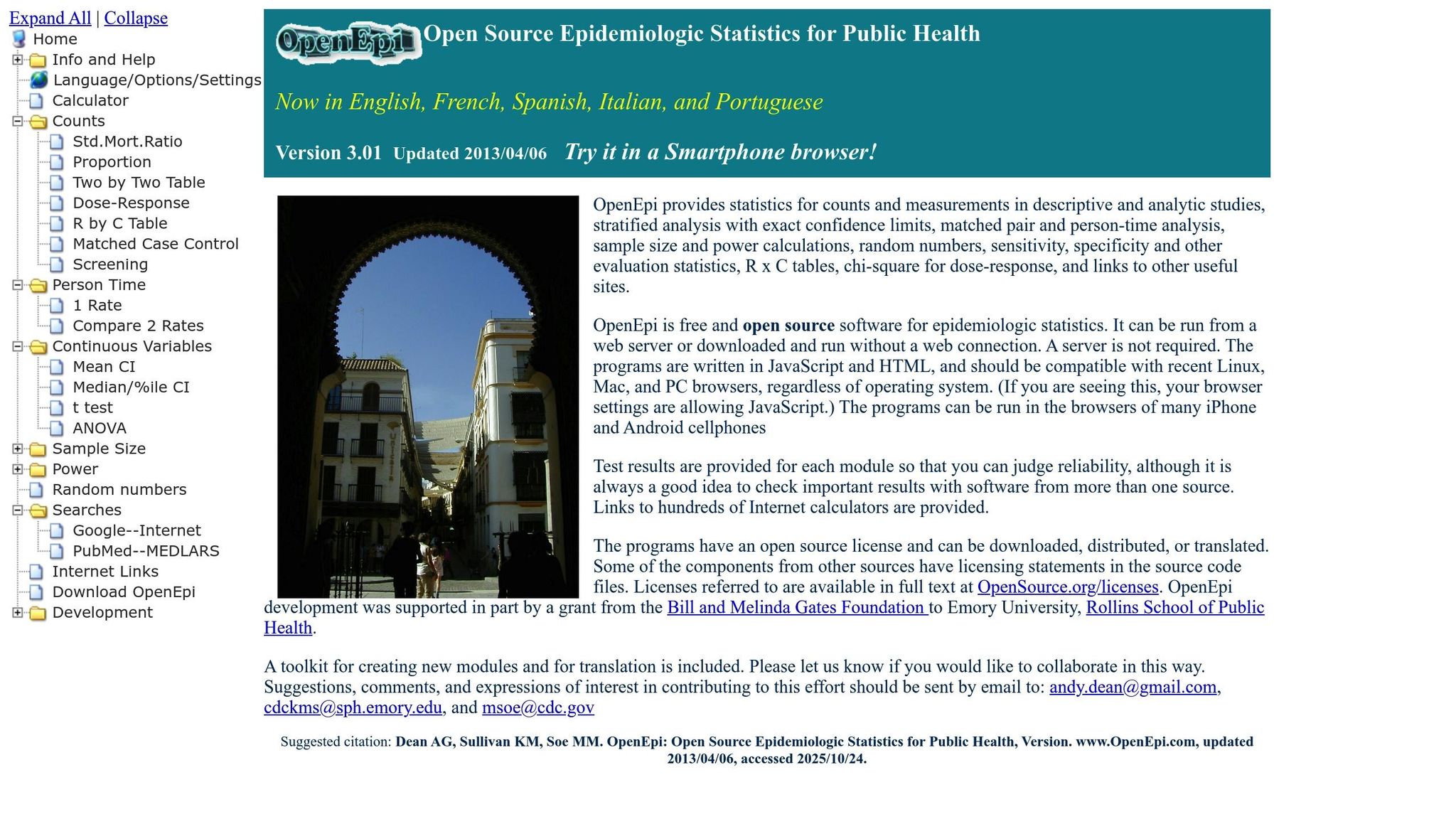
OpenEpi is a free, open-source tool designed specifically for epidemiological research. Unlike tools that prioritize financial metrics, OpenEpi is all about delivering insights tailored to health-focused investigations, making it a go-to resource for public health professionals and researchers.
Cohort Analysis Features
OpenEpi allows users to break down study groups based on key factors like patient demographics, treatment results, disease progression, and clinical trial data. It supports classic epidemiological methods such as tracking disease prevalence, analyzing outbreak patterns, and assessing treatment effectiveness. While its focus on public health research is clear, it doesn’t cater to typical SaaS metrics like monthly recurring revenue (MRR), customer lifetime value, or subscription churn analysis.
Integration Options
Unlike many SaaS analytics tools, OpenEpi doesn’t come with built-in integrations for popular business platforms. If custom integrations are needed, users will require advanced technical expertise to set them up.
Cost
OpenEpi is entirely free, with no hidden fees or premium versions. This makes it especially appealing to academic institutions, non-profits, and health-tech startups working within the realm of epidemiology.
Best Fit for Research
This tool is tailored for specialized epidemiological studies rather than large-scale enterprise analytics. It’s ideal for smaller, focused research projects rather than handling high-volume data analysis.
10. Lucid Financials
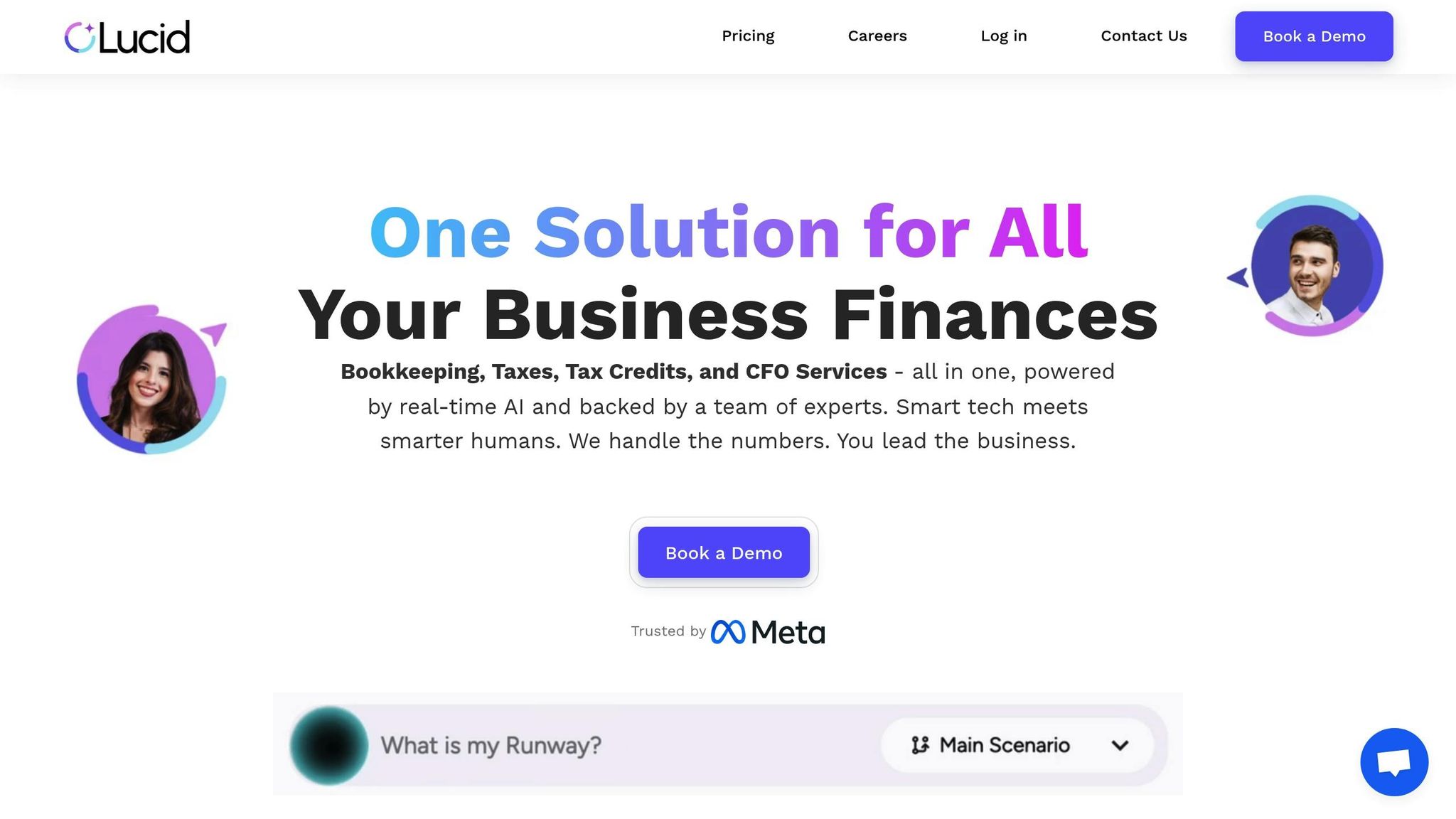
Lucid Financials is breaking new ground as the first AI-powered, full-stack accounting firm tailored specifically for startups. By combining financial management with AI-driven analytics, it uncovers revenue patterns and customer value, making it an essential tool for SaaS companies looking to streamline financial planning.
The platform uses customer segmentation based on shared financial traits - like signup dates, subscription tiers, or revenue milestones - to track key metrics such as retention, churn, and revenue trends. Its AI system digs deep into these segments, identifying critical behavioral and financial patterns. This allows founders and finance teams to quickly spot growth opportunities and potential risks without the hassle of manual analysis.
What sets Lucid Financials apart is its integration of financial cohort analysis with accounting and CFO services. This means you can handle bookkeeping, tax preparation, and financial analysis all in one place, giving you a clear picture of how different customer groups impact your overall financial health.
Integration with SaaS Tools
Lucid Financials takes its functionality a step further by connecting seamlessly with popular SaaS tools. It integrates with Slack to provide real-time notifications and AI-powered insights. Additionally, it syncs with accounting, billing, and CRM platforms to ensure your financial and user data is always up to date. The platform also connects to payment processors like Stripe and PayPal, CRM systems, product analytics tools, and bank accounts, creating a unified view of your financial ecosystem.
Pricing (USD/month)
Lucid Financials offers a straightforward subscription model starting at $150 per month. Pricing applies to each service area - Bookkeeping, Tax, CFO/Fundraising - and includes early-stage discounts for startups. This flat-rate structure eliminates the uncertainty of hourly billing and hidden fees, making it an appealing choice for businesses working within tight budgets.
Startup Scalability
Built with growing startups in mind, Lucid Financials automates financial operations while delivering investor-ready reports as your company scales. The platform aligns financial data with user cohorts, ensuring it can handle increasing volumes of data and reporting needs effortlessly.
"As we scaled, budgeting and cash flow became critical. Lucid's CFO services give us the visibility we need, while their bookkeeping and tax support keep everything accurate and stress-free. It's been a game-changer for our operations." - Luka Mutinda, Founder and CEO @Dukapaq
Lucid Financials also offers tools to support scalability, such as instant financial planning, real-time runway insights, and AI-powered scenario modeling. With clean financial records ready in just seven days and always-on investor reporting, the platform equips SaaS companies to tackle complex financial challenges and meet investor expectations with confidence.
Tool Comparison Chart
Here's a breakdown of key features, pricing, integrations, and strengths to help you pick the best cohort analysis tool for your needs.
| Tool | Key Cohort Features | Pricing (USD/month) | Best Integrations | Ideal For | Main Strengths |
|---|---|---|---|---|---|
| Amplitude | Advanced behavioral segmentation, predictive analytics, custom cohort creation | Free plan available; custom enterprise pricing | Data warehouses (Snowflake, Redshift), CRMs, product analytics stacks | Mid-to-large SaaS companies with dedicated product teams | Deep behavioral insights and predictive modeling |
| Mixpanel | Funnel analysis, retention tracking with revenue overlays, custom user segments | Free tier; paid plans starting at $25/month | Major data warehouses, CRMs, billing platforms | Product and growth teams focused on user behavior | Strong funnel and retention analysis capabilities |
| Heap | Automatic event tracking, code-free analytics, behavioral cohorts | Free tier available; paid plans from $99/month | Data warehouses, CRMs, product tools | Teams wanting automatic analytics without manual setup | No-code event capture and easy implementation |
| ChartMogul | Subscription cohorts, MRR tracking, and LTV analysis | Usage-based pricing; starts around $100/month | Stripe, Shopify, QuickBooks, billing platforms | Finance teams managing subscription revenue | Plug-and-play financial cohort analysis |
| Google Analytics 4 | Web and app cohorts with flexible date-based segmentation | Free for most users; enterprise options available | Google Ads, Firebase, other Google services | Businesses of all sizes tracking web/app users | Free access and seamless integration with Google tools |
| Lucid Financials | Financial cohorts integrated with accounting, AI-powered insights, revenue pattern analysis | Starting at $150/month per service area | Slack, Stripe, PayPal, accounting platforms, banks | Startups and fast-growing companies needing integrated financial insights | Combined financial management and cohort analysis with AI support |
This chart complements the detailed reviews above, highlighting each tool's strengths. Google Analytics 4 is a great starting point with its free tier, while platforms like ChartMogul and Lucid Financials cater to advanced needs with higher price points.
Integration and setup requirements vary. Tools like Amplitude, Mixpanel, and Heap integrate seamlessly with data warehouses and product analytics stacks. Heap stands out for its automatic event tracking, making it easy to get started, whereas Amplitude and Mixpanel demand more technical setup but deliver deeper insights. Lucid Financials offers real-time financial insights through Slack, simplifying financial and cohort analysis for fast-paced teams.
For startups, choosing the right tool means balancing features with budget. Lucid Financials provides a unique combination of cohort analysis and financial management, reducing the need for multiple vendors while offering investor-ready reports.
Each tool shines in specific areas. Amplitude is ideal for predictive analytics, ChartMogul is perfect for subscription metrics, and Lucid Financials merges financial management with cohort insights. Use this chart to identify which tool aligns with your business priorities and operational goals.
Final Thoughts
Cohort analysis has become a must-have for SaaS businesses in 2025, offering deep insights into user retention, customer lifetime value, and revenue trends. By grouping users based on shared traits - like signup dates or subscription plans - companies can uncover strategies that drive growth and pinpoint groups that may need extra attention.
AI-powered cohort analysis tools take this a step further by automating tasks like data integration, identifying patterns, and delivering predictive insights. These tools allow teams to quickly act on data, turning what used to be time-consuming manual processes into real-time operations.
Take, for example, a SaaS company using Mixpanel. They discovered that improving their onboarding process significantly boosted user retention. By refining how new users were introduced to their platform, they not only reduced churn but also drove revenue growth.
When choosing the right tool, it’s all about your company’s stage and needs. Early-stage startups often benefit from simple, plug-and-play solutions with easy-to-navigate dashboards. On the other hand, scaling companies may need advanced segmentation and custom reporting tools. AI-driven platforms like Lucid Financials stand out by combining financial and cohort analysis into a seamless, real-time experience.
Lucid Financials uses AI to provide real-time financial and cohort reporting, making it a great fit for startups and fast-growing businesses. It also integrates effortlessly with broader financial planning tools.
Successful SaaS businesses often prioritize tools that connect with billing platforms, CRMs, and communication apps like Slack. These integrations ensure smooth data flow and richer insights.
As your business grows, it’s essential to invest in platforms that can handle large datasets from multiple sources. Strong cohort analysis capabilities lead to better retention, lower churn, and more predictable revenue - key ingredients for thriving in today’s competitive market.
FAQs
How can AI-powered cohort analysis tools enhance the accuracy and efficiency of insights for SaaS businesses?
AI-powered cohort analysis tools simplify the task of examining user behavior over time, delivering sharper insights that SaaS businesses can act on. By using machine learning, these tools quickly identify patterns, trends, and anomalies in customer data, enabling faster and more informed decision-making.
They also cut down on manual work by automating data collection and creating visualizations, ensuring results are accurate while saving valuable time. With access to real-time insights and predictive analytics, SaaS companies can gain a clearer picture of customer retention, spot growth opportunities, and fine-tune their strategies to achieve better outcomes.
What should SaaS companies look for when choosing a cohort analysis tool?
When choosing a cohort analysis tool, SaaS businesses should prioritize a few essential factors. Start with ease of integration - the tool should connect seamlessly with your existing systems to avoid unnecessary headaches. Next, evaluate the quality of insights it provides. The data should be clear, actionable, and detailed enough to guide your decisions. And don't forget about scalability - you'll want a tool that grows with your company.
Equally important is the user experience. A good tool should be intuitive and easy to use, whether you're a data analyst or someone without a technical background. This ensures that all team members can make the most of the tool without a steep learning curve.
Finally, think about how the tool fits into your broader goals. For instance, platforms like Lucid Financials not only simplify financial management but also offer real-time insights and investor-ready reports. These features can amplify the value of your cohort analysis by tying the data back to your financial and operational strategies. Picking tools that align with your overall business objectives creates a more unified and effective growth plan.
How does using cohort analysis tools with SaaS platforms improve business decision-making?
Cohort analysis tools, when integrated with SaaS platforms, empower businesses to make informed, data-driven decisions by revealing trends in user behavior over time. These tools allow companies to dive into customer retention patterns, spending habits, and product performance, offering actionable insights that can refine growth strategies.
By organizing and analyzing data more efficiently, businesses can better anticipate future needs, allocate resources wisely, and maintain focus on scaling their operations. This approach not only simplifies decision-making but also ensures leaders have access to the critical information they need, exactly when they need it.
